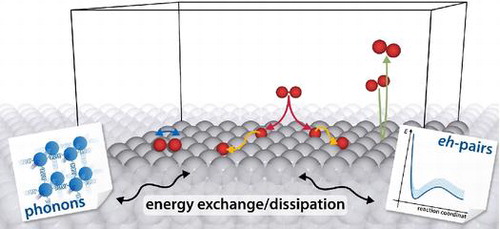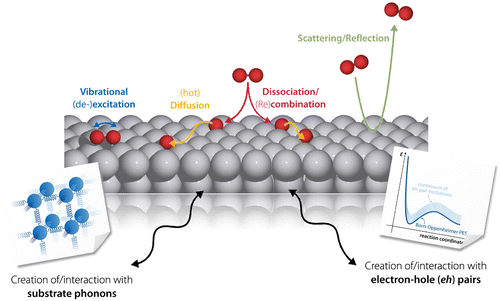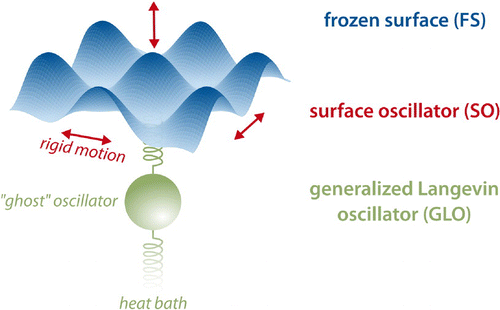Figures & data

Figure 1. Various elementary processes in the context of GSD. An impinging molecule may, for instance, be directly reflected from the metal substrate, nevertheless exchanging energy and momentum with the surface. It may, however, as well dissociate on the surface – potentially through a vibrational precursor state – with the excess kinetic energy leading to hyperthermal motion of the fragments, so-called ‘hot diffusion’. In all of these processes, energy exchange with the metal occurring either through the excitation of lattice vibrations (phonons) or non-adiabatic electron–hole (eh)-pairs may significantly influence the resulting dynamics.

Figure 2. Hierarchical approaches to enrich simulations on a FS PES with an account of lattice motion. The SO model first introduces a 3D harmonic oscillator corresponding to a rigid shift of the entire PES in all spatial directions, thus allowing for adsorbate–surface energy transfer following a simple collision model. Building on this, the GLO adds a further ghost oscillator linearly coupled to the SO, which in turn is further coupled to a heat bath within an effective generalized Langevin description. This allows to also include energy dissipation from the SO to the bulk.

Figure 3. Construction of electronic friction coefficients within the LDFA [Citation123]. The interacting molecule-surface system is first approximated through independent atoms being embedded in the electron density of the clean metal surface. The local electronic density at the atomic positions is then used to independently map to an isotropic atomic embedding model system of a spherically symmetric impurity in jellium. Finally, electronic friction coefficients are evaluated from the scattering phase shifts of the Kohn–Sham states at the Fermi-momentum for this model [Citation118,Citation119,Citation124,Citation126]. This ultimately yields, for each element, an electronic friction coefficient as a function of the embedding density and can thus be conveniently evaluated and tabulated prior to dynamical simulations. It has later been suggested to introduce molecular information by constructing the embedding density via a suitable Hirshfeld-partitioning [Citation140] of the full system electronic density [Citation141].
![Figure 3. Construction of electronic friction coefficients within the LDFA [Citation123]. The interacting molecule-surface system is first approximated through independent atoms being embedded in the electron density of the clean metal surface. The local electronic density at the atomic positions is then used to independently map to an isotropic atomic embedding model system of a spherically symmetric impurity in jellium. Finally, electronic friction coefficients are evaluated from the scattering phase shifts of the Kohn–Sham states at the Fermi-momentum for this model [Citation118,Citation119,Citation124,Citation126]. This ultimately yields, for each element, an electronic friction coefficient as a function of the embedding density and can thus be conveniently evaluated and tabulated prior to dynamical simulations. It has later been suggested to introduce molecular information by constructing the embedding density via a suitable Hirshfeld-partitioning [Citation140] of the full system electronic density [Citation141].](/cms/asset/2e0ef15b-7cfc-4aef-a3cd-c19666748969/tapx_a_1381574_f0003_oc.gif)
Figure 4. Schematic illustration of the QM/Me embedding approach, applied here to the dissociative adsorption over Pd(100) [Citation190]. A QM description of the immediate reaction zone is based on periodic DFT calculations to yield an accurate description of the short range, adsorbate-induced chemical interactions. This QM-cell is embedded into an Me substrate that is treated at the level of a numerically efficient classical interatomic potential to provide the elastic contribution to the forces due to deformation of the lattice. Released chemical energy is thus dissipated out of the ‘hot’ reaction zone and into a ‘cold’ macroscopic heat bath, while atoms in the embedding cell are color-coded according to kinetic energy.
![Figure 4. Schematic illustration of the QM/Me embedding approach, applied here to the dissociative adsorption over Pd(100) [Citation190]. A QM description of the immediate reaction zone is based on periodic DFT calculations to yield an accurate description of the short range, adsorbate-induced chemical interactions. This QM-cell is embedded into an Me substrate that is treated at the level of a numerically efficient classical interatomic potential to provide the elastic contribution to the forces due to deformation of the lattice. Released chemical energy is thus dissipated out of the ‘hot’ reaction zone and into a ‘cold’ macroscopic heat bath, while atoms in the embedding cell are color-coded according to kinetic energy.](/cms/asset/1b36d059-e8e5-4d64-a09f-7143f368845b/tapx_a_1381574_f0004_oc.gif)
